Stockroom Restaurant: Issues and Solutions
VerifiedAdded on 2023/03/29
|15
|5195
|133
AI Summary
This report provides an overview of the Stockroom restaurant and the issues they are currently facing. It analyzes the internal and external issues, and offers solutions to resolve these issues and improve the overall effectiveness of Stockroom.
Contribute Materials
Your contribution can guide someone’s learning journey. Share your
documents today.
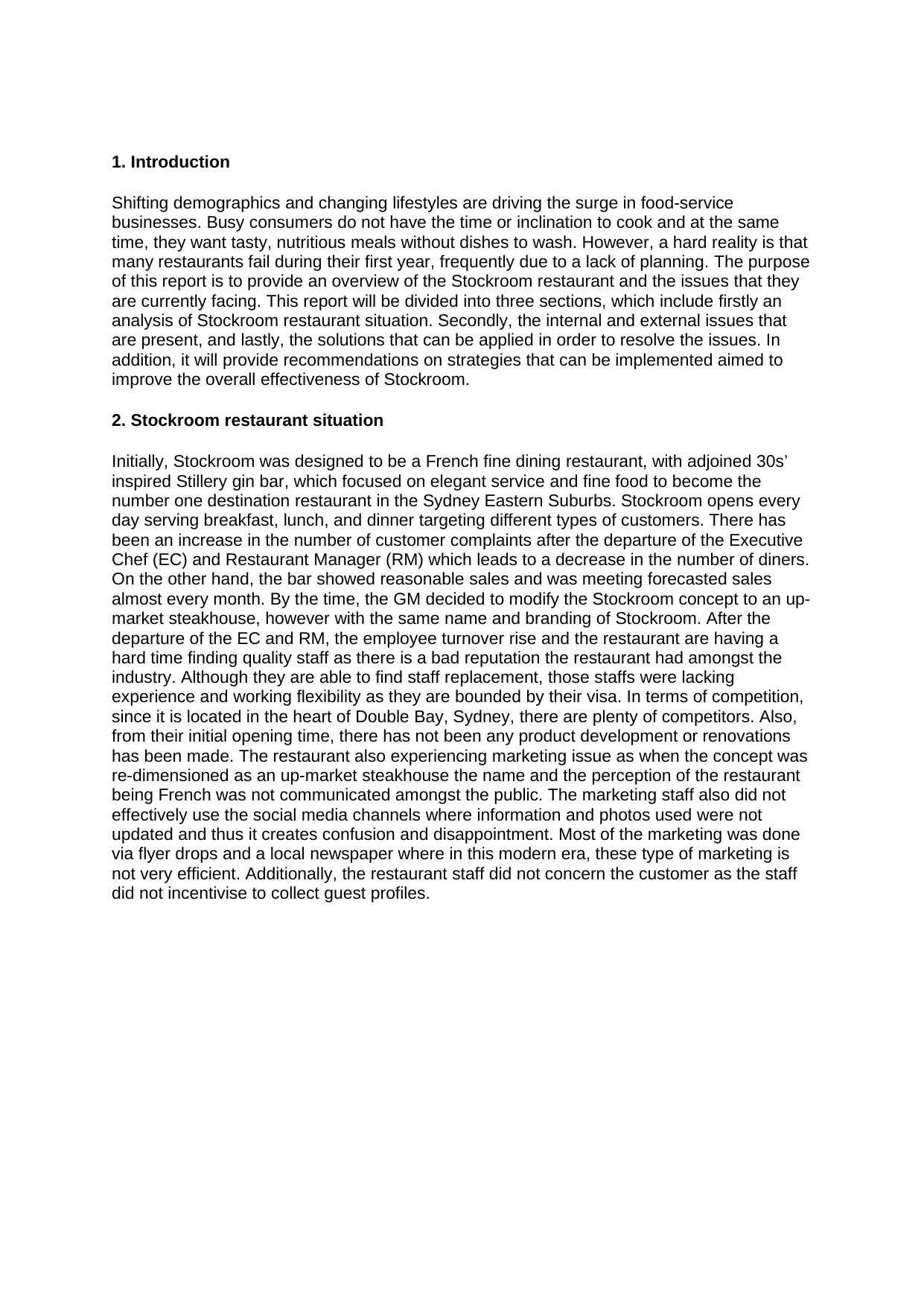
1. Introduction
Shifting demographics and changing lifestyles are driving the surge in food-service
businesses. Busy consumers do not have the time or inclination to cook and at the same
time, they want tasty, nutritious meals without dishes to wash. However, a hard reality is that
many restaurants fail during their first year, frequently due to a lack of planning. The purpose
of this report is to provide an overview of the Stockroom restaurant and the issues that they
are currently facing. This report will be divided into three sections, which include firstly an
analysis of Stockroom restaurant situation. Secondly, the internal and external issues that
are present, and lastly, the solutions that can be applied in order to resolve the issues. In
addition, it will provide recommendations on strategies that can be implemented aimed to
improve the overall effectiveness of Stockroom.
2. Stockroom restaurant situation
Initially, Stockroom was designed to be a French fine dining restaurant, with adjoined 30s’
inspired Stillery gin bar, which focused on elegant service and fine food to become the
number one destination restaurant in the Sydney Eastern Suburbs. Stockroom opens every
day serving breakfast, lunch, and dinner targeting different types of customers. There has
been an increase in the number of customer complaints after the departure of the Executive
Chef (EC) and Restaurant Manager (RM) which leads to a decrease in the number of diners.
On the other hand, the bar showed reasonable sales and was meeting forecasted sales
almost every month. By the time, the GM decided to modify the Stockroom concept to an up-
market steakhouse, however with the same name and branding of Stockroom. After the
departure of the EC and RM, the employee turnover rise and the restaurant are having a
hard time finding quality staff as there is a bad reputation the restaurant had amongst the
industry. Although they are able to find staff replacement, those staffs were lacking
experience and working flexibility as they are bounded by their visa. In terms of competition,
since it is located in the heart of Double Bay, Sydney, there are plenty of competitors. Also,
from their initial opening time, there has not been any product development or renovations
has been made. The restaurant also experiencing marketing issue as when the concept was
re-dimensioned as an up-market steakhouse the name and the perception of the restaurant
being French was not communicated amongst the public. The marketing staff also did not
effectively use the social media channels where information and photos used were not
updated and thus it creates confusion and disappointment. Most of the marketing was done
via flyer drops and a local newspaper where in this modern era, these type of marketing is
not very efficient. Additionally, the restaurant staff did not concern the customer as the staff
did not incentivise to collect guest profiles.
Shifting demographics and changing lifestyles are driving the surge in food-service
businesses. Busy consumers do not have the time or inclination to cook and at the same
time, they want tasty, nutritious meals without dishes to wash. However, a hard reality is that
many restaurants fail during their first year, frequently due to a lack of planning. The purpose
of this report is to provide an overview of the Stockroom restaurant and the issues that they
are currently facing. This report will be divided into three sections, which include firstly an
analysis of Stockroom restaurant situation. Secondly, the internal and external issues that
are present, and lastly, the solutions that can be applied in order to resolve the issues. In
addition, it will provide recommendations on strategies that can be implemented aimed to
improve the overall effectiveness of Stockroom.
2. Stockroom restaurant situation
Initially, Stockroom was designed to be a French fine dining restaurant, with adjoined 30s’
inspired Stillery gin bar, which focused on elegant service and fine food to become the
number one destination restaurant in the Sydney Eastern Suburbs. Stockroom opens every
day serving breakfast, lunch, and dinner targeting different types of customers. There has
been an increase in the number of customer complaints after the departure of the Executive
Chef (EC) and Restaurant Manager (RM) which leads to a decrease in the number of diners.
On the other hand, the bar showed reasonable sales and was meeting forecasted sales
almost every month. By the time, the GM decided to modify the Stockroom concept to an up-
market steakhouse, however with the same name and branding of Stockroom. After the
departure of the EC and RM, the employee turnover rise and the restaurant are having a
hard time finding quality staff as there is a bad reputation the restaurant had amongst the
industry. Although they are able to find staff replacement, those staffs were lacking
experience and working flexibility as they are bounded by their visa. In terms of competition,
since it is located in the heart of Double Bay, Sydney, there are plenty of competitors. Also,
from their initial opening time, there has not been any product development or renovations
has been made. The restaurant also experiencing marketing issue as when the concept was
re-dimensioned as an up-market steakhouse the name and the perception of the restaurant
being French was not communicated amongst the public. The marketing staff also did not
effectively use the social media channels where information and photos used were not
updated and thus it creates confusion and disappointment. Most of the marketing was done
via flyer drops and a local newspaper where in this modern era, these type of marketing is
not very efficient. Additionally, the restaurant staff did not concern the customer as the staff
did not incentivise to collect guest profiles.
Secure Best Marks with AI Grader
Need help grading? Try our AI Grader for instant feedback on your assignments.
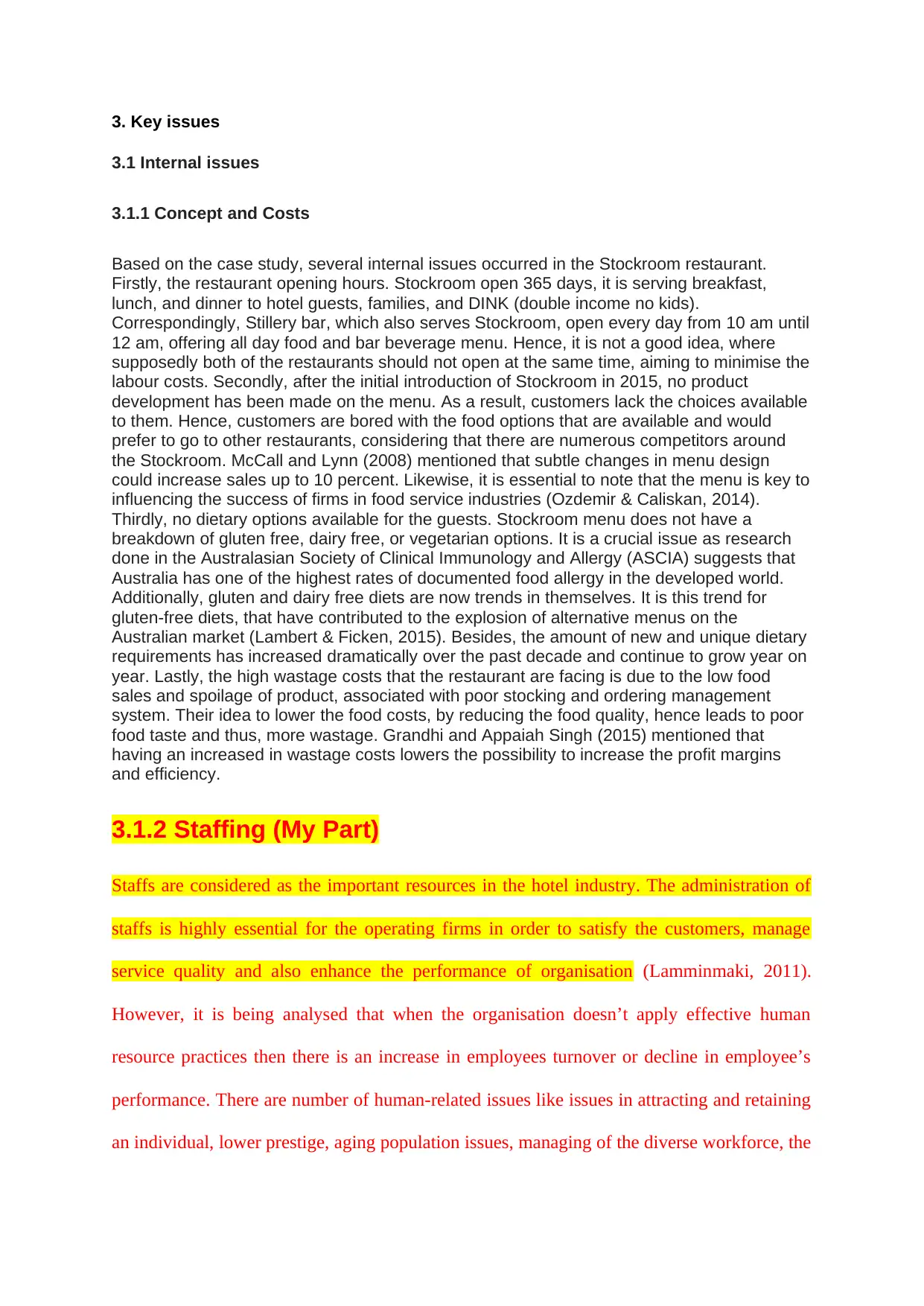
3. Key issues
3.1 Internal issues
3.1.1 Concept and Costs
Based on the case study, several internal issues occurred in the Stockroom restaurant.
Firstly, the restaurant opening hours. Stockroom open 365 days, it is serving breakfast,
lunch, and dinner to hotel guests, families, and DINK (double income no kids).
Correspondingly, Stillery bar, which also serves Stockroom, open every day from 10 am until
12 am, offering all day food and bar beverage menu. Hence, it is not a good idea, where
supposedly both of the restaurants should not open at the same time, aiming to minimise the
labour costs. Secondly, after the initial introduction of Stockroom in 2015, no product
development has been made on the menu. As a result, customers lack the choices available
to them. Hence, customers are bored with the food options that are available and would
prefer to go to other restaurants, considering that there are numerous competitors around
the Stockroom. McCall and Lynn (2008) mentioned that subtle changes in menu design
could increase sales up to 10 percent. Likewise, it is essential to note that the menu is key to
influencing the success of firms in food service industries (Ozdemir & Caliskan, 2014).
Thirdly, no dietary options available for the guests. Stockroom menu does not have a
breakdown of gluten free, dairy free, or vegetarian options. It is a crucial issue as research
done in the Australasian Society of Clinical Immunology and Allergy (ASCIA) suggests that
Australia has one of the highest rates of documented food allergy in the developed world.
Additionally, gluten and dairy free diets are now trends in themselves. It is this trend for
gluten-free diets, that have contributed to the explosion of alternative menus on the
Australian market (Lambert & Ficken, 2015). Besides, the amount of new and unique dietary
requirements has increased dramatically over the past decade and continue to grow year on
year. Lastly, the high wastage costs that the restaurant are facing is due to the low food
sales and spoilage of product, associated with poor stocking and ordering management
system. Their idea to lower the food costs, by reducing the food quality, hence leads to poor
food taste and thus, more wastage. Grandhi and Appaiah Singh (2015) mentioned that
having an increased in wastage costs lowers the possibility to increase the profit margins
and efficiency.
3.1.2 Staffing (My Part)
Staffs are considered as the important resources in the hotel industry. The administration of
staffs is highly essential for the operating firms in order to satisfy the customers, manage
service quality and also enhance the performance of organisation (Lamminmaki, 2011).
However, it is being analysed that when the organisation doesn’t apply effective human
resource practices then there is an increase in employees turnover or decline in employee’s
performance. There are number of human-related issues like issues in attracting and retaining
an individual, lower prestige, aging population issues, managing of the diverse workforce, the
3.1 Internal issues
3.1.1 Concept and Costs
Based on the case study, several internal issues occurred in the Stockroom restaurant.
Firstly, the restaurant opening hours. Stockroom open 365 days, it is serving breakfast,
lunch, and dinner to hotel guests, families, and DINK (double income no kids).
Correspondingly, Stillery bar, which also serves Stockroom, open every day from 10 am until
12 am, offering all day food and bar beverage menu. Hence, it is not a good idea, where
supposedly both of the restaurants should not open at the same time, aiming to minimise the
labour costs. Secondly, after the initial introduction of Stockroom in 2015, no product
development has been made on the menu. As a result, customers lack the choices available
to them. Hence, customers are bored with the food options that are available and would
prefer to go to other restaurants, considering that there are numerous competitors around
the Stockroom. McCall and Lynn (2008) mentioned that subtle changes in menu design
could increase sales up to 10 percent. Likewise, it is essential to note that the menu is key to
influencing the success of firms in food service industries (Ozdemir & Caliskan, 2014).
Thirdly, no dietary options available for the guests. Stockroom menu does not have a
breakdown of gluten free, dairy free, or vegetarian options. It is a crucial issue as research
done in the Australasian Society of Clinical Immunology and Allergy (ASCIA) suggests that
Australia has one of the highest rates of documented food allergy in the developed world.
Additionally, gluten and dairy free diets are now trends in themselves. It is this trend for
gluten-free diets, that have contributed to the explosion of alternative menus on the
Australian market (Lambert & Ficken, 2015). Besides, the amount of new and unique dietary
requirements has increased dramatically over the past decade and continue to grow year on
year. Lastly, the high wastage costs that the restaurant are facing is due to the low food
sales and spoilage of product, associated with poor stocking and ordering management
system. Their idea to lower the food costs, by reducing the food quality, hence leads to poor
food taste and thus, more wastage. Grandhi and Appaiah Singh (2015) mentioned that
having an increased in wastage costs lowers the possibility to increase the profit margins
and efficiency.
3.1.2 Staffing (My Part)
Staffs are considered as the important resources in the hotel industry. The administration of
staffs is highly essential for the operating firms in order to satisfy the customers, manage
service quality and also enhance the performance of organisation (Lamminmaki, 2011).
However, it is being analysed that when the organisation doesn’t apply effective human
resource practices then there is an increase in employees turnover or decline in employee’s
performance. There are number of human-related issues like issues in attracting and retaining
an individual, lower prestige, aging population issues, managing of the diverse workforce, the
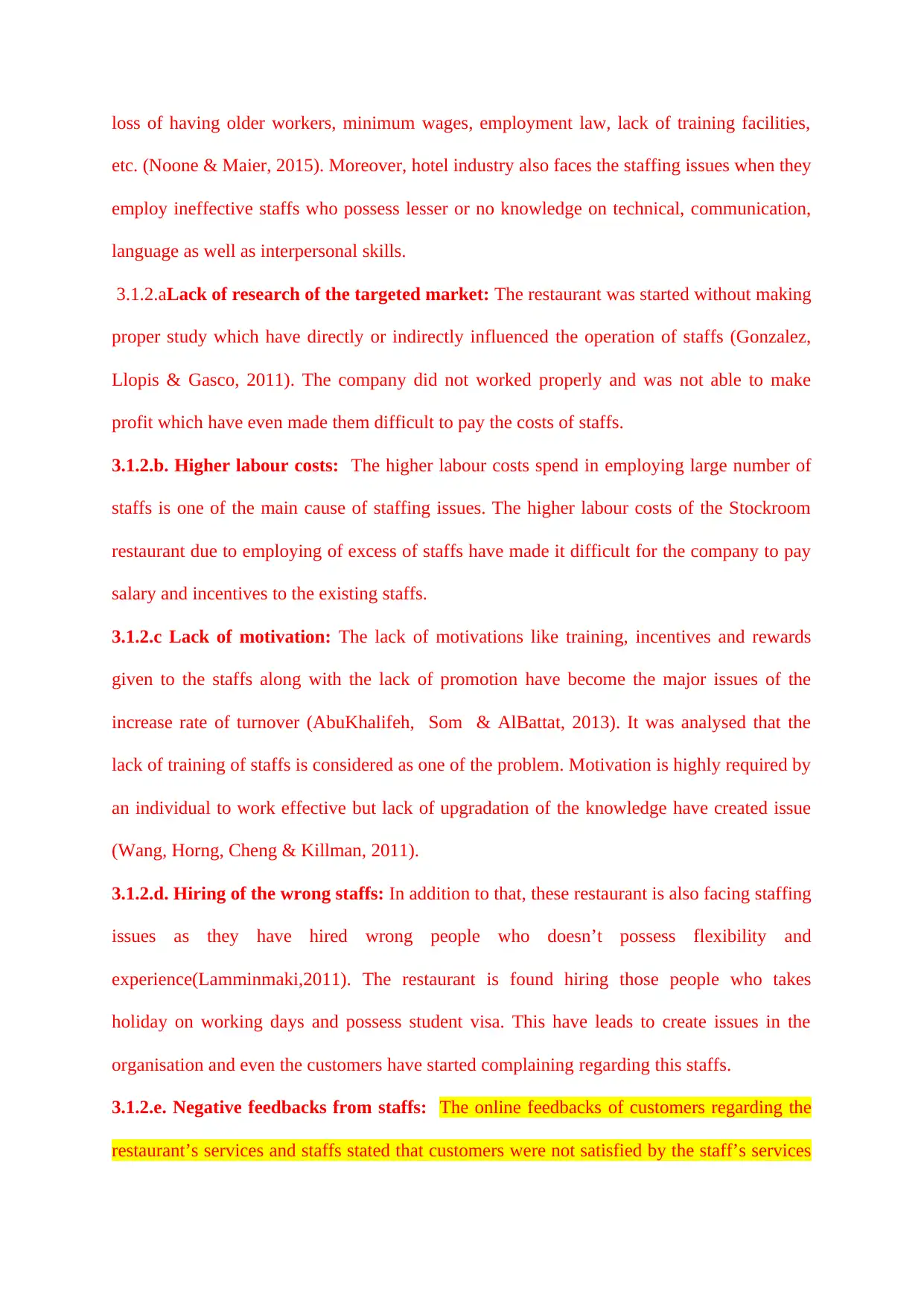
loss of having older workers, minimum wages, employment law, lack of training facilities,
etc. (Noone & Maier, 2015). Moreover, hotel industry also faces the staffing issues when they
employ ineffective staffs who possess lesser or no knowledge on technical, communication,
language as well as interpersonal skills.
3.1.2.aLack of research of the targeted market: The restaurant was started without making
proper study which have directly or indirectly influenced the operation of staffs (Gonzalez,
Llopis & Gasco, 2011). The company did not worked properly and was not able to make
profit which have even made them difficult to pay the costs of staffs.
3.1.2.b. Higher labour costs: The higher labour costs spend in employing large number of
staffs is one of the main cause of staffing issues. The higher labour costs of the Stockroom
restaurant due to employing of excess of staffs have made it difficult for the company to pay
salary and incentives to the existing staffs.
3.1.2.c Lack of motivation: The lack of motivations like training, incentives and rewards
given to the staffs along with the lack of promotion have become the major issues of the
increase rate of turnover (AbuKhalifeh, Som & AlBattat, 2013). It was analysed that the
lack of training of staffs is considered as one of the problem. Motivation is highly required by
an individual to work effective but lack of upgradation of the knowledge have created issue
(Wang, Horng, Cheng & Killman, 2011).
3.1.2.d. Hiring of the wrong staffs: In addition to that, these restaurant is also facing staffing
issues as they have hired wrong people who doesn’t possess flexibility and
experience(Lamminmaki,2011). The restaurant is found hiring those people who takes
holiday on working days and possess student visa. This have leads to create issues in the
organisation and even the customers have started complaining regarding this staffs.
3.1.2.e. Negative feedbacks from staffs: The online feedbacks of customers regarding the
restaurant’s services and staffs stated that customers were not satisfied by the staff’s services
etc. (Noone & Maier, 2015). Moreover, hotel industry also faces the staffing issues when they
employ ineffective staffs who possess lesser or no knowledge on technical, communication,
language as well as interpersonal skills.
3.1.2.aLack of research of the targeted market: The restaurant was started without making
proper study which have directly or indirectly influenced the operation of staffs (Gonzalez,
Llopis & Gasco, 2011). The company did not worked properly and was not able to make
profit which have even made them difficult to pay the costs of staffs.
3.1.2.b. Higher labour costs: The higher labour costs spend in employing large number of
staffs is one of the main cause of staffing issues. The higher labour costs of the Stockroom
restaurant due to employing of excess of staffs have made it difficult for the company to pay
salary and incentives to the existing staffs.
3.1.2.c Lack of motivation: The lack of motivations like training, incentives and rewards
given to the staffs along with the lack of promotion have become the major issues of the
increase rate of turnover (AbuKhalifeh, Som & AlBattat, 2013). It was analysed that the
lack of training of staffs is considered as one of the problem. Motivation is highly required by
an individual to work effective but lack of upgradation of the knowledge have created issue
(Wang, Horng, Cheng & Killman, 2011).
3.1.2.d. Hiring of the wrong staffs: In addition to that, these restaurant is also facing staffing
issues as they have hired wrong people who doesn’t possess flexibility and
experience(Lamminmaki,2011). The restaurant is found hiring those people who takes
holiday on working days and possess student visa. This have leads to create issues in the
organisation and even the customers have started complaining regarding this staffs.
3.1.2.e. Negative feedbacks from staffs: The online feedbacks of customers regarding the
restaurant’s services and staffs stated that customers were not satisfied by the staff’s services

and many of them even told that they won’t visits the place again (Davidson, McPhail &
Barry, 2011). These created bad reputation of the restaurant which further created issue as it
has become difficult for the restaurant to recruit new staffs.
It had been analysed from the case study that the ineffective operation of the restaurant has
led to number of issues regarding staffing(Lamminmaki,2011). The issues of staffing have
further declined the restaurant’s performance and thus, it is important for the restaurant so as
to implement effective strategies in order to retain the existing staffs and recruit the new
employees.
3.2 External issues
(Andrea)
4. Low budget strategy and solutions
4.1 Increase the sales of stockroom like this(divided topic)
4.1.1. Menu expansion
Several different solutions can be applied to resolve the above issues and increase the sales
of the stockroom. As there has been no development made to the restaurant after the initial
introduction, to increase the sales, expanding the menu may resolve it. According to McCall
and Lynn (2008), a menu is much more than words on a paper, and it can convey many
things such as personality, level of care put into each dish, and the type of experience that is
aimed to deliver to the guests. In addition, the restaurant menu sits at the core of a
restaurant's strategy. Furthermore, being creative in designing the menu in this globalisation
era is a must (Lambert & Ficken, 2015). For instance, many individuals want more healthy
options, customizable dishes and value-oriented choices. Some specific restaurant
segments seem develop for more innovation in menu categories that play to their inherent
strengths, like customisation. Boland (2008) claims that consumers tend to be satisfied with
Barry, 2011). These created bad reputation of the restaurant which further created issue as it
has become difficult for the restaurant to recruit new staffs.
It had been analysed from the case study that the ineffective operation of the restaurant has
led to number of issues regarding staffing(Lamminmaki,2011). The issues of staffing have
further declined the restaurant’s performance and thus, it is important for the restaurant so as
to implement effective strategies in order to retain the existing staffs and recruit the new
employees.
3.2 External issues
(Andrea)
4. Low budget strategy and solutions
4.1 Increase the sales of stockroom like this(divided topic)
4.1.1. Menu expansion
Several different solutions can be applied to resolve the above issues and increase the sales
of the stockroom. As there has been no development made to the restaurant after the initial
introduction, to increase the sales, expanding the menu may resolve it. According to McCall
and Lynn (2008), a menu is much more than words on a paper, and it can convey many
things such as personality, level of care put into each dish, and the type of experience that is
aimed to deliver to the guests. In addition, the restaurant menu sits at the core of a
restaurant's strategy. Furthermore, being creative in designing the menu in this globalisation
era is a must (Lambert & Ficken, 2015). For instance, many individuals want more healthy
options, customizable dishes and value-oriented choices. Some specific restaurant
segments seem develop for more innovation in menu categories that play to their inherent
strengths, like customisation. Boland (2008) claims that consumers tend to be satisfied with
Paraphrase This Document
Need a fresh take? Get an instant paraphrase of this document with our AI Paraphraser

such highly customizable options. In fact, more customisation may be the way restaurants
cut down the size of their menu boards while still satisfying consumers who want more
choice when they dine out and more control over the experience (Boland, 2008).
Furthermore, Tristano (2015) claim that younger individuals are leading the movement,
where this can be seen that the millennial counts for the highest population in Australia (see
appendix). They are wanting for more menu items and innovations. Tristano (2015) adds
that consumers aged 18 to 34 indicate a preference for more offerings at a higher rate than
consumers 35 and older in every category. Besides,Zimmerman and Darnold (2009)believe
that by having a vegetarian or gluten-free options can also increase sales. This is because it
can be an advantage as it can set the restaurant apart from the competitors.
4.1.2. Happy offer promotion
Next, providing offers and happy hour in a limited time. It is no doubt that giving an offer is
one of the best means to attract already existing and new customers to the restaurant
(Scozzafava, Contini, Romano & Casini, 2017). For instance, in 2016, Domino's Pizza in
India came up with a "Navaratri Combo" offering special ingredients and recipes commonly
used during the festival to the consumers. A strategy of this kind will improve the restaurant
sales during the festive season (Goyal & Singh, 2007). Thus, during the Christmas and New
Years' time, offering a complimentary Christmas pudding or liquor chocolates may attract
more customers and hence increase the number of sales. Also, the importance of happy
hour strategies. For instance, as liquor brings the highest number of sales and profit in a
restaurant, offering a plate of any food items with any liquor drinks will help in upselling the
menu items (Goyal & Singh, 2007). The greatest thing in regard to happy hours is that it is
targeted at the slow sales trading period, as it can potentially attract customers and thus,
result in higher sales (Goyal & Singh, 2007).
4.1.3. Social media as a marketing tool
The fast development and the rise in the use of social media platforms such as Facebook,
Instagram, and Twitter is opening a new path for the business to attract customers (). Hence,
the best way to increase restaurant sales is by harnessing this force and making the
presence on these platforms. A survey conducted in 2009, found that more than 70 percent
of the managers believe that social media is a more effective way of marketing than the
traditional one (flyer and newspaper) because is considered as an efficient tools to increase
revenue at a low cost. As well the survey showed that 25 percent of social media users
comment about an advertisement, and 35 percent forwarded the advertisement. According
to the last, posting in social media can increase the brand’s visibility. The restaurant can
update the information about the new concept and reinforce the brand name in the
customer’s minds (Montalvo, 2011). However, it is important to note that having the pages
updated regularly by uploading pictures and posts about upcoming events that the
restaurant will be hosting is a must to increase its effectiveness. Thus, to make this happen,
the strategy is to have a different person than the hotel marketing manager to handle the
online marketing in the restaurant and bar focusing in manage, update social media,
respond comments and generate a positive electronic word of mouth about the services and
products offered by the restaurant and bar (Lee, 2011). In addition, social media is especially
beneficial when having to make announcements regarding special offers or discounts. This
can be seen that in Figure 2 (see appendix), more than 46 percent of customers following
brands via social media, where discounts (61 percent) is the most popular benefit people like
to receive from brands they follow.
4.1.4. Online ordering as a different ways to purchase the food
cut down the size of their menu boards while still satisfying consumers who want more
choice when they dine out and more control over the experience (Boland, 2008).
Furthermore, Tristano (2015) claim that younger individuals are leading the movement,
where this can be seen that the millennial counts for the highest population in Australia (see
appendix). They are wanting for more menu items and innovations. Tristano (2015) adds
that consumers aged 18 to 34 indicate a preference for more offerings at a higher rate than
consumers 35 and older in every category. Besides,Zimmerman and Darnold (2009)believe
that by having a vegetarian or gluten-free options can also increase sales. This is because it
can be an advantage as it can set the restaurant apart from the competitors.
4.1.2. Happy offer promotion
Next, providing offers and happy hour in a limited time. It is no doubt that giving an offer is
one of the best means to attract already existing and new customers to the restaurant
(Scozzafava, Contini, Romano & Casini, 2017). For instance, in 2016, Domino's Pizza in
India came up with a "Navaratri Combo" offering special ingredients and recipes commonly
used during the festival to the consumers. A strategy of this kind will improve the restaurant
sales during the festive season (Goyal & Singh, 2007). Thus, during the Christmas and New
Years' time, offering a complimentary Christmas pudding or liquor chocolates may attract
more customers and hence increase the number of sales. Also, the importance of happy
hour strategies. For instance, as liquor brings the highest number of sales and profit in a
restaurant, offering a plate of any food items with any liquor drinks will help in upselling the
menu items (Goyal & Singh, 2007). The greatest thing in regard to happy hours is that it is
targeted at the slow sales trading period, as it can potentially attract customers and thus,
result in higher sales (Goyal & Singh, 2007).
4.1.3. Social media as a marketing tool
The fast development and the rise in the use of social media platforms such as Facebook,
Instagram, and Twitter is opening a new path for the business to attract customers (). Hence,
the best way to increase restaurant sales is by harnessing this force and making the
presence on these platforms. A survey conducted in 2009, found that more than 70 percent
of the managers believe that social media is a more effective way of marketing than the
traditional one (flyer and newspaper) because is considered as an efficient tools to increase
revenue at a low cost. As well the survey showed that 25 percent of social media users
comment about an advertisement, and 35 percent forwarded the advertisement. According
to the last, posting in social media can increase the brand’s visibility. The restaurant can
update the information about the new concept and reinforce the brand name in the
customer’s minds (Montalvo, 2011). However, it is important to note that having the pages
updated regularly by uploading pictures and posts about upcoming events that the
restaurant will be hosting is a must to increase its effectiveness. Thus, to make this happen,
the strategy is to have a different person than the hotel marketing manager to handle the
online marketing in the restaurant and bar focusing in manage, update social media,
respond comments and generate a positive electronic word of mouth about the services and
products offered by the restaurant and bar (Lee, 2011). In addition, social media is especially
beneficial when having to make announcements regarding special offers or discounts. This
can be seen that in Figure 2 (see appendix), more than 46 percent of customers following
brands via social media, where discounts (61 percent) is the most popular benefit people like
to receive from brands they follow.
4.1.4. Online ordering as a different ways to purchase the food
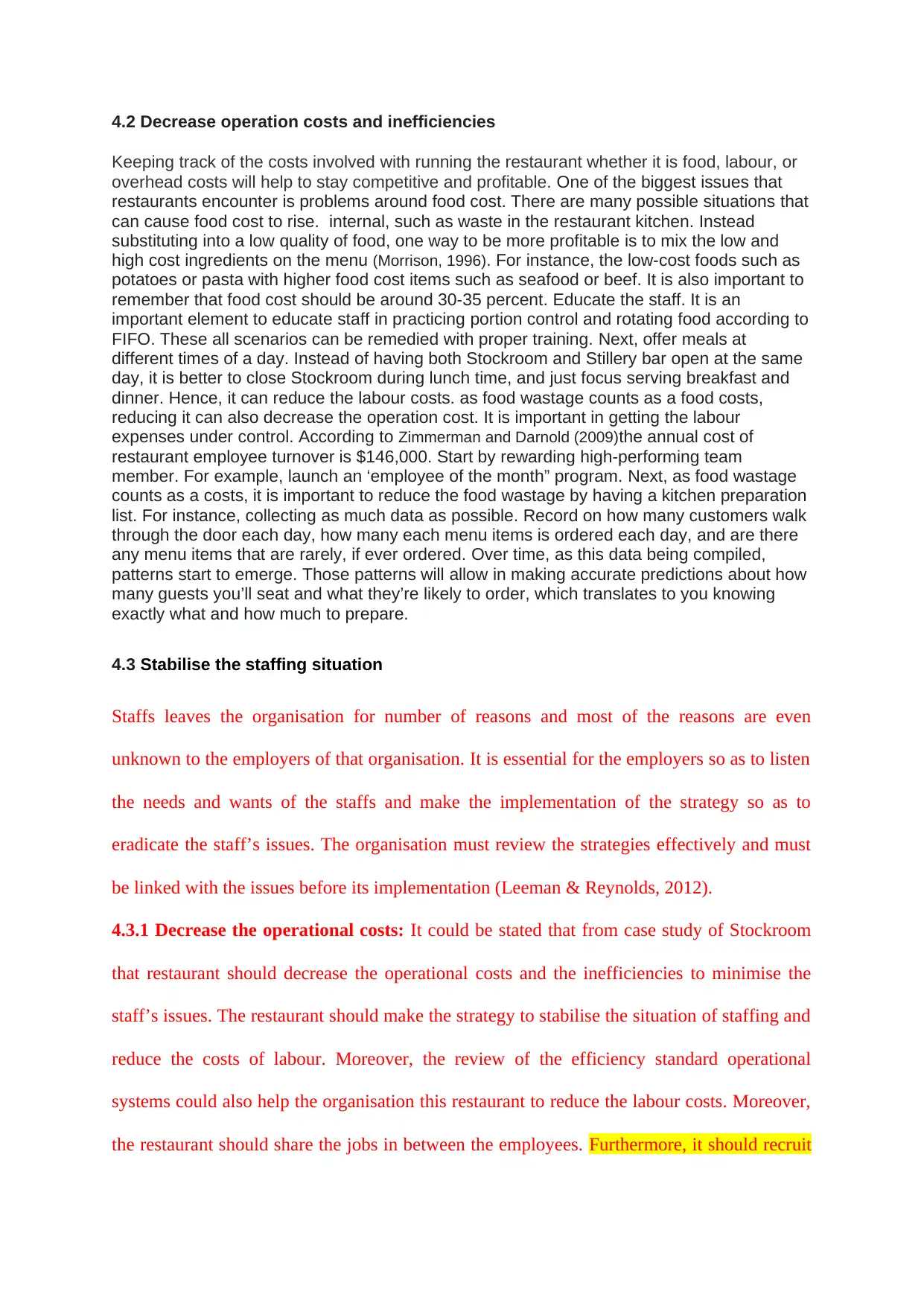
4.2 Decrease operation costs and inefficiencies
Keeping track of the costs involved with running the restaurant whether it is food, labour, or
overhead costs will help to stay competitive and profitable. One of the biggest issues that
restaurants encounter is problems around food cost. There are many possible situations that
can cause food cost to rise. internal, such as waste in the restaurant kitchen. Instead
substituting into a low quality of food, one way to be more profitable is to mix the low and
high cost ingredients on the menu (Morrison, 1996). For instance, the low-cost foods such as
potatoes or pasta with higher food cost items such as seafood or beef. It is also important to
remember that food cost should be around 30-35 percent. Educate the staff. It is an
important element to educate staff in practicing portion control and rotating food according to
FIFO. These all scenarios can be remedied with proper training. Next, offer meals at
different times of a day. Instead of having both Stockroom and Stillery bar open at the same
day, it is better to close Stockroom during lunch time, and just focus serving breakfast and
dinner. Hence, it can reduce the labour costs. as food wastage counts as a food costs,
reducing it can also decrease the operation cost. It is important in getting the labour
expenses under control. According to Zimmerman and Darnold (2009)the annual cost of
restaurant employee turnover is $146,000. Start by rewarding high-performing team
member. For example, launch an ‘employee of the month” program. Next, as food wastage
counts as a costs, it is important to reduce the food wastage by having a kitchen preparation
list. For instance, collecting as much data as possible. Record on how many customers walk
through the door each day, how many each menu items is ordered each day, and are there
any menu items that are rarely, if ever ordered. Over time, as this data being compiled,
patterns start to emerge. Those patterns will allow in making accurate predictions about how
many guests you’ll seat and what they’re likely to order, which translates to you knowing
exactly what and how much to prepare.
4.3 Stabilise the staffing situation
Staffs leaves the organisation for number of reasons and most of the reasons are even
unknown to the employers of that organisation. It is essential for the employers so as to listen
the needs and wants of the staffs and make the implementation of the strategy so as to
eradicate the staff’s issues. The organisation must review the strategies effectively and must
be linked with the issues before its implementation (Leeman & Reynolds, 2012).
4.3.1 Decrease the operational costs: It could be stated that from case study of Stockroom
that restaurant should decrease the operational costs and the inefficiencies to minimise the
staff’s issues. The restaurant should make the strategy to stabilise the situation of staffing and
reduce the costs of labour. Moreover, the review of the efficiency standard operational
systems could also help the organisation this restaurant to reduce the labour costs. Moreover,
the restaurant should share the jobs in between the employees. Furthermore, it should recruit
Keeping track of the costs involved with running the restaurant whether it is food, labour, or
overhead costs will help to stay competitive and profitable. One of the biggest issues that
restaurants encounter is problems around food cost. There are many possible situations that
can cause food cost to rise. internal, such as waste in the restaurant kitchen. Instead
substituting into a low quality of food, one way to be more profitable is to mix the low and
high cost ingredients on the menu (Morrison, 1996). For instance, the low-cost foods such as
potatoes or pasta with higher food cost items such as seafood or beef. It is also important to
remember that food cost should be around 30-35 percent. Educate the staff. It is an
important element to educate staff in practicing portion control and rotating food according to
FIFO. These all scenarios can be remedied with proper training. Next, offer meals at
different times of a day. Instead of having both Stockroom and Stillery bar open at the same
day, it is better to close Stockroom during lunch time, and just focus serving breakfast and
dinner. Hence, it can reduce the labour costs. as food wastage counts as a food costs,
reducing it can also decrease the operation cost. It is important in getting the labour
expenses under control. According to Zimmerman and Darnold (2009)the annual cost of
restaurant employee turnover is $146,000. Start by rewarding high-performing team
member. For example, launch an ‘employee of the month” program. Next, as food wastage
counts as a costs, it is important to reduce the food wastage by having a kitchen preparation
list. For instance, collecting as much data as possible. Record on how many customers walk
through the door each day, how many each menu items is ordered each day, and are there
any menu items that are rarely, if ever ordered. Over time, as this data being compiled,
patterns start to emerge. Those patterns will allow in making accurate predictions about how
many guests you’ll seat and what they’re likely to order, which translates to you knowing
exactly what and how much to prepare.
4.3 Stabilise the staffing situation
Staffs leaves the organisation for number of reasons and most of the reasons are even
unknown to the employers of that organisation. It is essential for the employers so as to listen
the needs and wants of the staffs and make the implementation of the strategy so as to
eradicate the staff’s issues. The organisation must review the strategies effectively and must
be linked with the issues before its implementation (Leeman & Reynolds, 2012).
4.3.1 Decrease the operational costs: It could be stated that from case study of Stockroom
that restaurant should decrease the operational costs and the inefficiencies to minimise the
staff’s issues. The restaurant should make the strategy to stabilise the situation of staffing and
reduce the costs of labour. Moreover, the review of the efficiency standard operational
systems could also help the organisation this restaurant to reduce the labour costs. Moreover,
the restaurant should share the jobs in between the employees. Furthermore, it should recruit
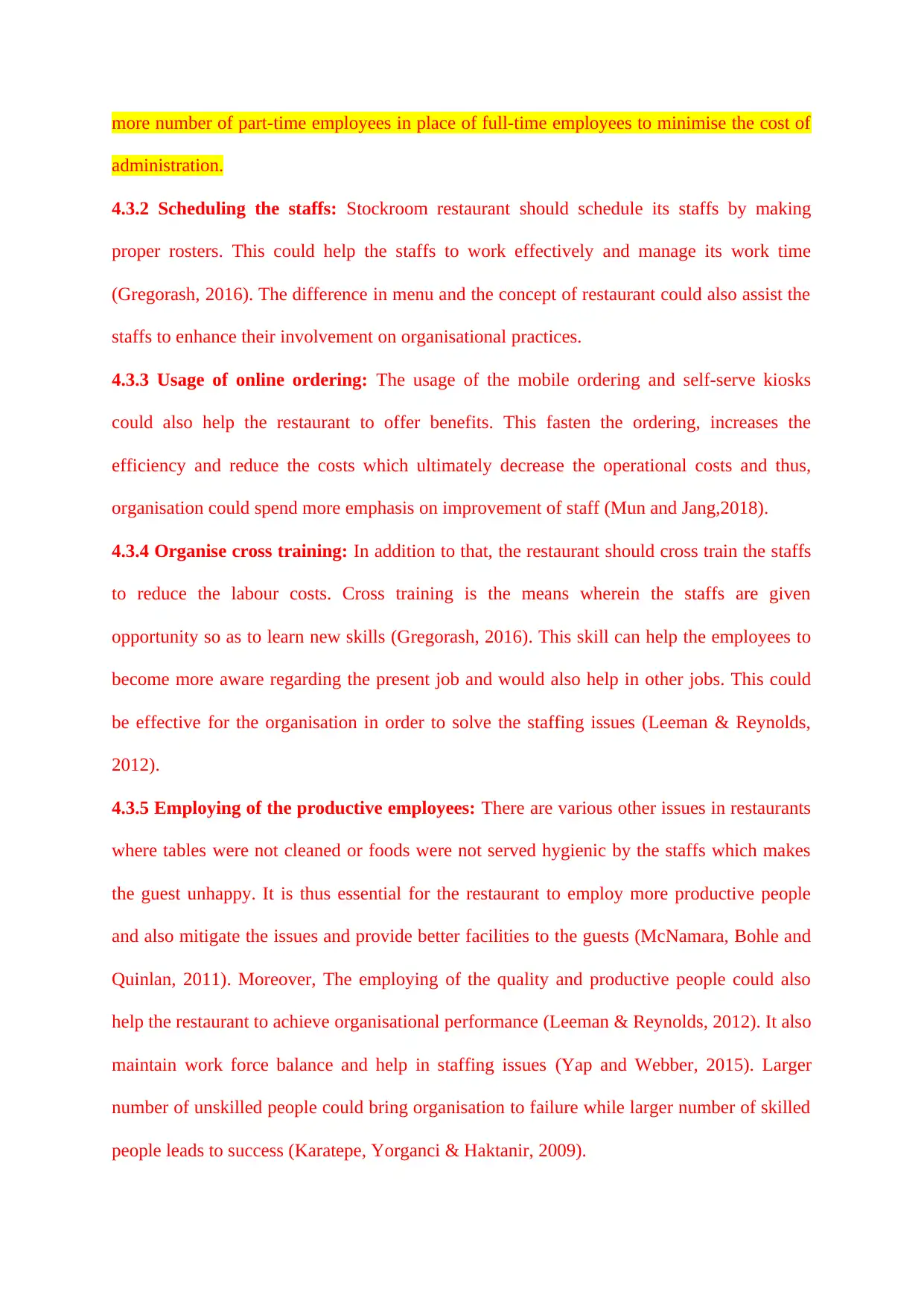
more number of part-time employees in place of full-time employees to minimise the cost of
administration.
4.3.2 Scheduling the staffs: Stockroom restaurant should schedule its staffs by making
proper rosters. This could help the staffs to work effectively and manage its work time
(Gregorash, 2016). The difference in menu and the concept of restaurant could also assist the
staffs to enhance their involvement on organisational practices.
4.3.3 Usage of online ordering: The usage of the mobile ordering and self-serve kiosks
could also help the restaurant to offer benefits. This fasten the ordering, increases the
efficiency and reduce the costs which ultimately decrease the operational costs and thus,
organisation could spend more emphasis on improvement of staff (Mun and Jang,2018).
4.3.4 Organise cross training: In addition to that, the restaurant should cross train the staffs
to reduce the labour costs. Cross training is the means wherein the staffs are given
opportunity so as to learn new skills (Gregorash, 2016). This skill can help the employees to
become more aware regarding the present job and would also help in other jobs. This could
be effective for the organisation in order to solve the staffing issues (Leeman & Reynolds,
2012).
4.3.5 Employing of the productive employees: There are various other issues in restaurants
where tables were not cleaned or foods were not served hygienic by the staffs which makes
the guest unhappy. It is thus essential for the restaurant to employ more productive people
and also mitigate the issues and provide better facilities to the guests (McNamara, Bohle and
Quinlan, 2011). Moreover, The employing of the quality and productive people could also
help the restaurant to achieve organisational performance (Leeman & Reynolds, 2012). It also
maintain work force balance and help in staffing issues (Yap and Webber, 2015). Larger
number of unskilled people could bring organisation to failure while larger number of skilled
people leads to success (Karatepe, Yorganci & Haktanir, 2009).
administration.
4.3.2 Scheduling the staffs: Stockroom restaurant should schedule its staffs by making
proper rosters. This could help the staffs to work effectively and manage its work time
(Gregorash, 2016). The difference in menu and the concept of restaurant could also assist the
staffs to enhance their involvement on organisational practices.
4.3.3 Usage of online ordering: The usage of the mobile ordering and self-serve kiosks
could also help the restaurant to offer benefits. This fasten the ordering, increases the
efficiency and reduce the costs which ultimately decrease the operational costs and thus,
organisation could spend more emphasis on improvement of staff (Mun and Jang,2018).
4.3.4 Organise cross training: In addition to that, the restaurant should cross train the staffs
to reduce the labour costs. Cross training is the means wherein the staffs are given
opportunity so as to learn new skills (Gregorash, 2016). This skill can help the employees to
become more aware regarding the present job and would also help in other jobs. This could
be effective for the organisation in order to solve the staffing issues (Leeman & Reynolds,
2012).
4.3.5 Employing of the productive employees: There are various other issues in restaurants
where tables were not cleaned or foods were not served hygienic by the staffs which makes
the guest unhappy. It is thus essential for the restaurant to employ more productive people
and also mitigate the issues and provide better facilities to the guests (McNamara, Bohle and
Quinlan, 2011). Moreover, The employing of the quality and productive people could also
help the restaurant to achieve organisational performance (Leeman & Reynolds, 2012). It also
maintain work force balance and help in staffing issues (Yap and Webber, 2015). Larger
number of unskilled people could bring organisation to failure while larger number of skilled
people leads to success (Karatepe, Yorganci & Haktanir, 2009).
Secure Best Marks with AI Grader
Need help grading? Try our AI Grader for instant feedback on your assignments.
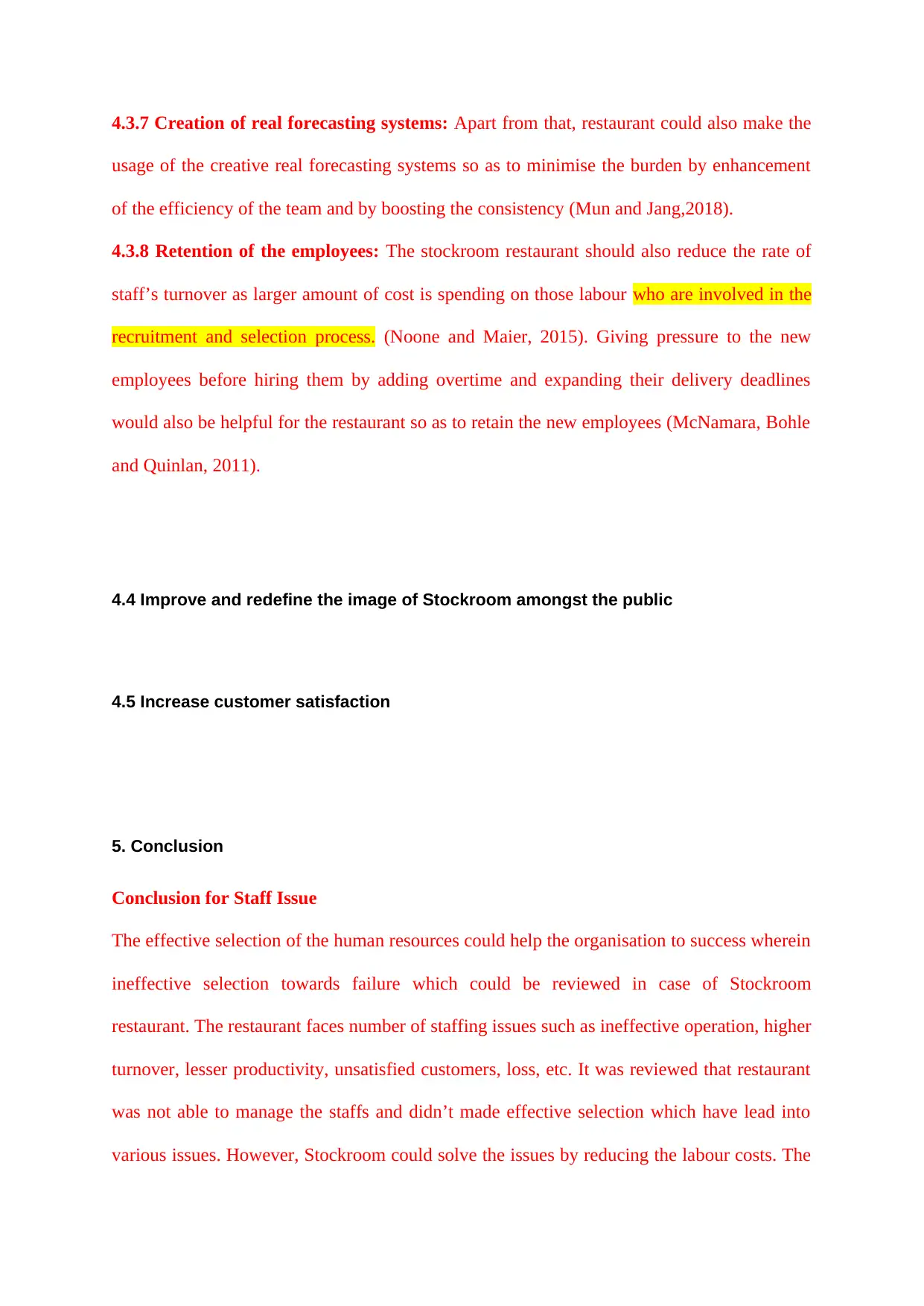
4.3.7 Creation of real forecasting systems: Apart from that, restaurant could also make the
usage of the creative real forecasting systems so as to minimise the burden by enhancement
of the efficiency of the team and by boosting the consistency (Mun and Jang,2018).
4.3.8 Retention of the employees: The stockroom restaurant should also reduce the rate of
staff’s turnover as larger amount of cost is spending on those labour who are involved in the
recruitment and selection process. (Noone and Maier, 2015). Giving pressure to the new
employees before hiring them by adding overtime and expanding their delivery deadlines
would also be helpful for the restaurant so as to retain the new employees (McNamara, Bohle
and Quinlan, 2011).
4.4 Improve and redefine the image of Stockroom amongst the public
4.5 Increase customer satisfaction
5. Conclusion
Conclusion for Staff Issue
The effective selection of the human resources could help the organisation to success wherein
ineffective selection towards failure which could be reviewed in case of Stockroom
restaurant. The restaurant faces number of staffing issues such as ineffective operation, higher
turnover, lesser productivity, unsatisfied customers, loss, etc. It was reviewed that restaurant
was not able to manage the staffs and didn’t made effective selection which have lead into
various issues. However, Stockroom could solve the issues by reducing the labour costs. The
usage of the creative real forecasting systems so as to minimise the burden by enhancement
of the efficiency of the team and by boosting the consistency (Mun and Jang,2018).
4.3.8 Retention of the employees: The stockroom restaurant should also reduce the rate of
staff’s turnover as larger amount of cost is spending on those labour who are involved in the
recruitment and selection process. (Noone and Maier, 2015). Giving pressure to the new
employees before hiring them by adding overtime and expanding their delivery deadlines
would also be helpful for the restaurant so as to retain the new employees (McNamara, Bohle
and Quinlan, 2011).
4.4 Improve and redefine the image of Stockroom amongst the public
4.5 Increase customer satisfaction
5. Conclusion
Conclusion for Staff Issue
The effective selection of the human resources could help the organisation to success wherein
ineffective selection towards failure which could be reviewed in case of Stockroom
restaurant. The restaurant faces number of staffing issues such as ineffective operation, higher
turnover, lesser productivity, unsatisfied customers, loss, etc. It was reviewed that restaurant
was not able to manage the staffs and didn’t made effective selection which have lead into
various issues. However, Stockroom could solve the issues by reducing the labour costs. The
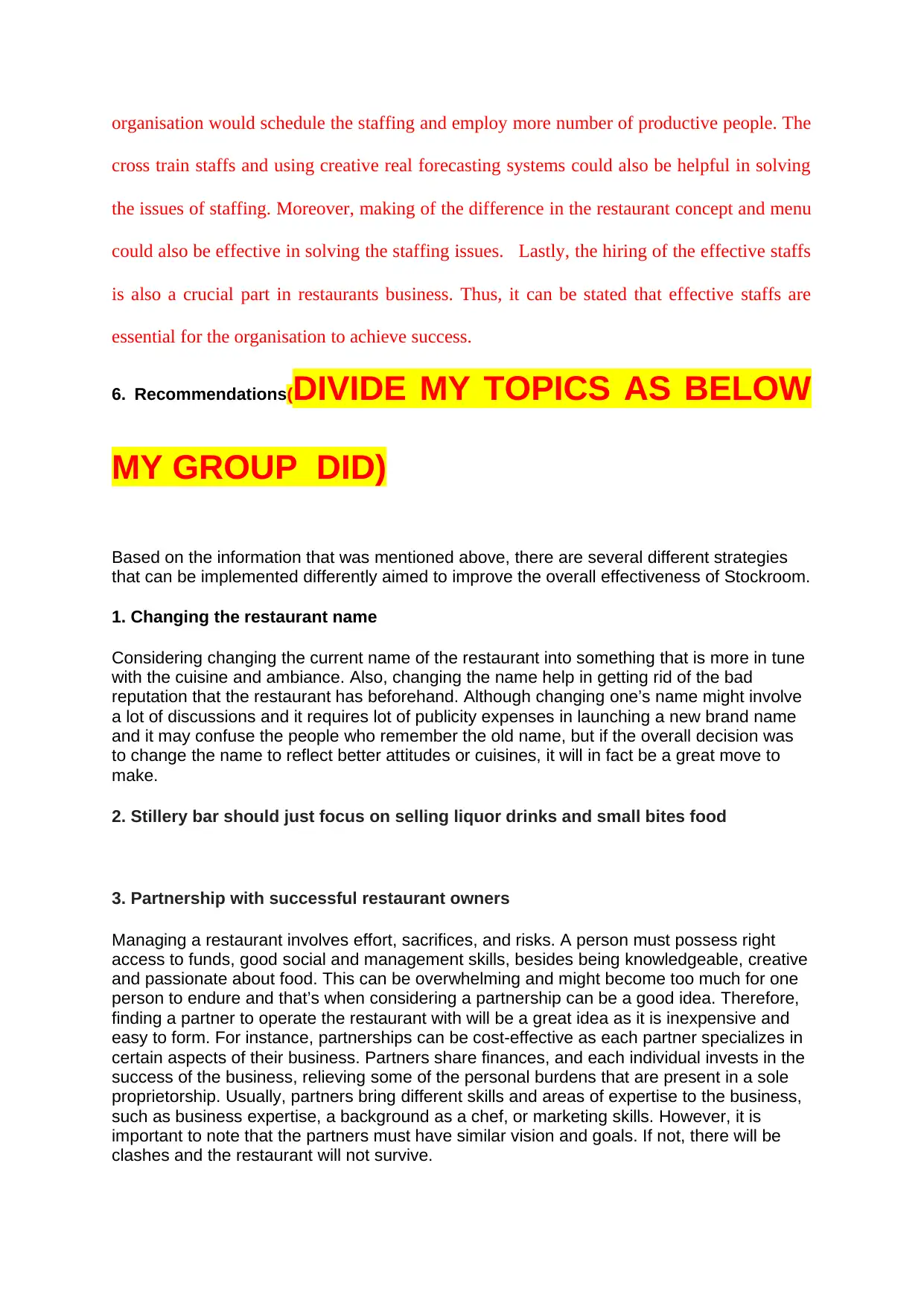
organisation would schedule the staffing and employ more number of productive people. The
cross train staffs and using creative real forecasting systems could also be helpful in solving
the issues of staffing. Moreover, making of the difference in the restaurant concept and menu
could also be effective in solving the staffing issues. Lastly, the hiring of the effective staffs
is also a crucial part in restaurants business. Thus, it can be stated that effective staffs are
essential for the organisation to achieve success.
6. Recommendations(DIVIDE MY TOPICS AS BELOW
MY GROUP DID)
Based on the information that was mentioned above, there are several different strategies
that can be implemented differently aimed to improve the overall effectiveness of Stockroom.
1. Changing the restaurant name
Considering changing the current name of the restaurant into something that is more in tune
with the cuisine and ambiance. Also, changing the name help in getting rid of the bad
reputation that the restaurant has beforehand. Although changing one’s name might involve
a lot of discussions and it requires lot of publicity expenses in launching a new brand name
and it may confuse the people who remember the old name, but if the overall decision was
to change the name to reflect better attitudes or cuisines, it will in fact be a great move to
make.
2. Stillery bar should just focus on selling liquor drinks and small bites food
3. Partnership with successful restaurant owners
Managing a restaurant involves effort, sacrifices, and risks. A person must possess right
access to funds, good social and management skills, besides being knowledgeable, creative
and passionate about food. This can be overwhelming and might become too much for one
person to endure and that’s when considering a partnership can be a good idea. Therefore,
finding a partner to operate the restaurant with will be a great idea as it is inexpensive and
easy to form. For instance, partnerships can be cost-effective as each partner specializes in
certain aspects of their business. Partners share finances, and each individual invests in the
success of the business, relieving some of the personal burdens that are present in a sole
proprietorship. Usually, partners bring different skills and areas of expertise to the business,
such as business expertise, a background as a chef, or marketing skills. However, it is
important to note that the partners must have similar vision and goals. If not, there will be
clashes and the restaurant will not survive.
cross train staffs and using creative real forecasting systems could also be helpful in solving
the issues of staffing. Moreover, making of the difference in the restaurant concept and menu
could also be effective in solving the staffing issues. Lastly, the hiring of the effective staffs
is also a crucial part in restaurants business. Thus, it can be stated that effective staffs are
essential for the organisation to achieve success.
6. Recommendations(DIVIDE MY TOPICS AS BELOW
MY GROUP DID)
Based on the information that was mentioned above, there are several different strategies
that can be implemented differently aimed to improve the overall effectiveness of Stockroom.
1. Changing the restaurant name
Considering changing the current name of the restaurant into something that is more in tune
with the cuisine and ambiance. Also, changing the name help in getting rid of the bad
reputation that the restaurant has beforehand. Although changing one’s name might involve
a lot of discussions and it requires lot of publicity expenses in launching a new brand name
and it may confuse the people who remember the old name, but if the overall decision was
to change the name to reflect better attitudes or cuisines, it will in fact be a great move to
make.
2. Stillery bar should just focus on selling liquor drinks and small bites food
3. Partnership with successful restaurant owners
Managing a restaurant involves effort, sacrifices, and risks. A person must possess right
access to funds, good social and management skills, besides being knowledgeable, creative
and passionate about food. This can be overwhelming and might become too much for one
person to endure and that’s when considering a partnership can be a good idea. Therefore,
finding a partner to operate the restaurant with will be a great idea as it is inexpensive and
easy to form. For instance, partnerships can be cost-effective as each partner specializes in
certain aspects of their business. Partners share finances, and each individual invests in the
success of the business, relieving some of the personal burdens that are present in a sole
proprietorship. Usually, partners bring different skills and areas of expertise to the business,
such as business expertise, a background as a chef, or marketing skills. However, it is
important to note that the partners must have similar vision and goals. If not, there will be
clashes and the restaurant will not survive.

Recommendations for Staff Issue
It is seen that Stockroom restaurant had faced lots of issues so it requires various changes in
its restaurants and thus, an appropriate recommendation is provided to the restaurant for
successful future (Yap and Webber, 2015). It is seen that the main concept is to reduce the
labour costs to eliminate the staffing issues.
Employing of effective manager: It is recommended that’s stockroom restaurant would
employ an effective manager who will have the leadership capability and potential to manage
the staffs smoothly. Since, the manager possesses the duty to satisfy the staffs so it is
recommended that Stockroom restaurant would employ those managers who can perform
well and manage the staffs effectively. This could further minimise the labour costs.
(AbuKhalifeh, Som & AlBattat, 2013).
Build good reputation: The Stockroom restaurant is further recommended to make a plan to
organise some social work and implement some technology to enhance its food and services
quality in order to achieve good reputation. This would help the organisation to recruit the
new staffs and save the cost of searching new candidates (Yap and Webber, 2015).
Improving the restaurant’s interior and exteriors designs: The restaurant would also
make some investments in the interior and exteriors so that it would create an effective
atmosphere for the staffs to work and customers could also feel positive coming to these
restaurants (Davidson, McPhail & Barry, 2011). This could result into positive comments and
feedbacks from the customers.
Serving quality foods and services: Since, the restaurant mainly achieve recognition
because of its quality of food and services. It is thus recommended that restaurant would
appoint the higher level chef to enhance the quality food and attract larger number of
customers towards them (Wang, Horng, Cheng and Killman, 2011). This could increase the
profitability and indirectly compensate the labour costs.
It is seen that Stockroom restaurant had faced lots of issues so it requires various changes in
its restaurants and thus, an appropriate recommendation is provided to the restaurant for
successful future (Yap and Webber, 2015). It is seen that the main concept is to reduce the
labour costs to eliminate the staffing issues.
Employing of effective manager: It is recommended that’s stockroom restaurant would
employ an effective manager who will have the leadership capability and potential to manage
the staffs smoothly. Since, the manager possesses the duty to satisfy the staffs so it is
recommended that Stockroom restaurant would employ those managers who can perform
well and manage the staffs effectively. This could further minimise the labour costs.
(AbuKhalifeh, Som & AlBattat, 2013).
Build good reputation: The Stockroom restaurant is further recommended to make a plan to
organise some social work and implement some technology to enhance its food and services
quality in order to achieve good reputation. This would help the organisation to recruit the
new staffs and save the cost of searching new candidates (Yap and Webber, 2015).
Improving the restaurant’s interior and exteriors designs: The restaurant would also
make some investments in the interior and exteriors so that it would create an effective
atmosphere for the staffs to work and customers could also feel positive coming to these
restaurants (Davidson, McPhail & Barry, 2011). This could result into positive comments and
feedbacks from the customers.
Serving quality foods and services: Since, the restaurant mainly achieve recognition
because of its quality of food and services. It is thus recommended that restaurant would
appoint the higher level chef to enhance the quality food and attract larger number of
customers towards them (Wang, Horng, Cheng and Killman, 2011). This could increase the
profitability and indirectly compensate the labour costs.
Paraphrase This Document
Need a fresh take? Get an instant paraphrase of this document with our AI Paraphraser
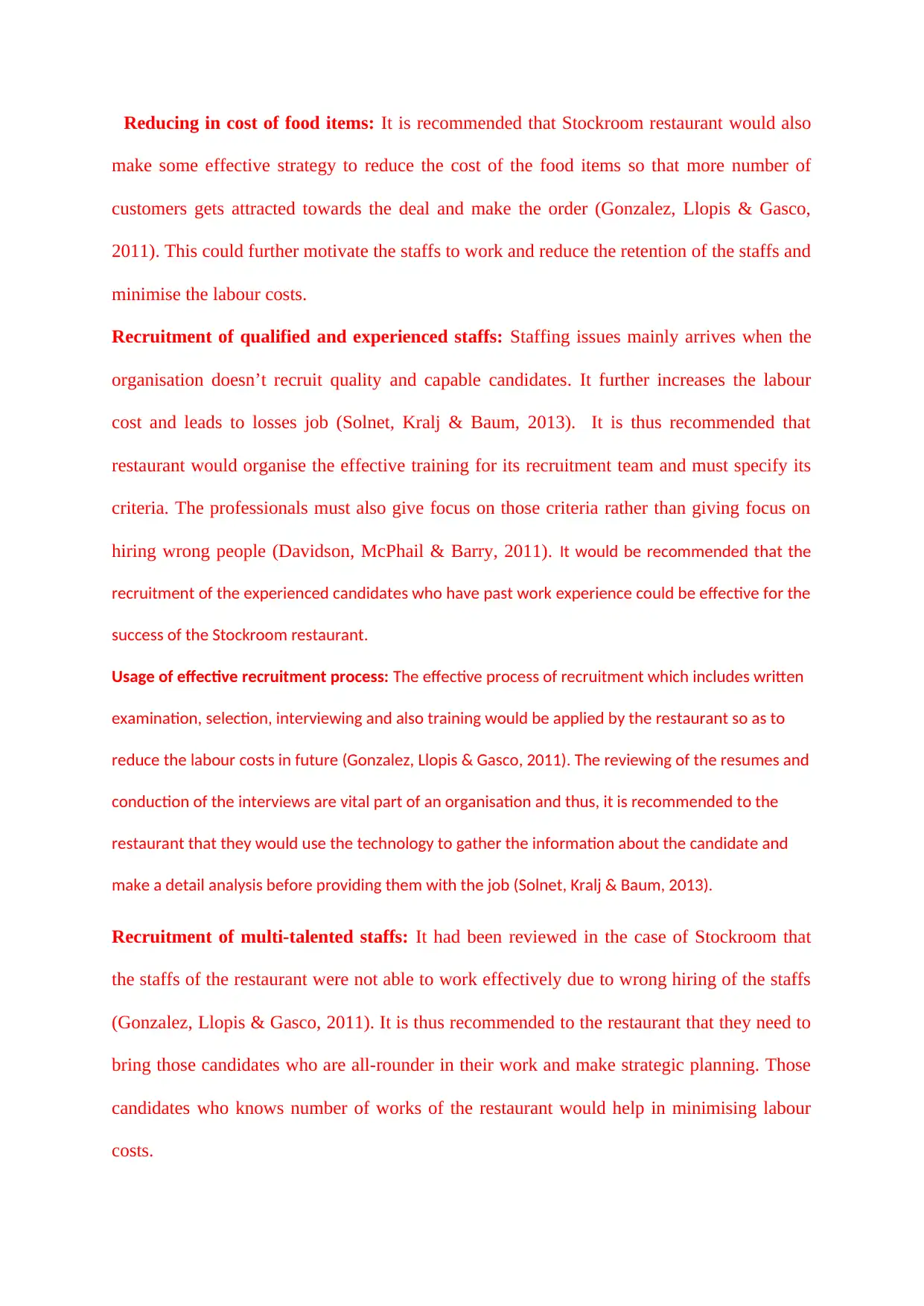
Reducing in cost of food items: It is recommended that Stockroom restaurant would also
make some effective strategy to reduce the cost of the food items so that more number of
customers gets attracted towards the deal and make the order (Gonzalez, Llopis & Gasco,
2011). This could further motivate the staffs to work and reduce the retention of the staffs and
minimise the labour costs.
Recruitment of qualified and experienced staffs: Staffing issues mainly arrives when the
organisation doesn’t recruit quality and capable candidates. It further increases the labour
cost and leads to losses job (Solnet, Kralj & Baum, 2013). It is thus recommended that
restaurant would organise the effective training for its recruitment team and must specify its
criteria. The professionals must also give focus on those criteria rather than giving focus on
hiring wrong people (Davidson, McPhail & Barry, 2011). It would be recommended that the
recruitment of the experienced candidates who have past work experience could be effective for the
success of the Stockroom restaurant.
Usage of effective recruitment process: The effective process of recruitment which includes written
examination, selection, interviewing and also training would be applied by the restaurant so as to
reduce the labour costs in future (Gonzalez, Llopis & Gasco, 2011). The reviewing of the resumes and
conduction of the interviews are vital part of an organisation and thus, it is recommended to the
restaurant that they would use the technology to gather the information about the candidate and
make a detail analysis before providing them with the job (Solnet, Kralj & Baum, 2013).
Recruitment of multi-talented staffs: It had been reviewed in the case of Stockroom that
the staffs of the restaurant were not able to work effectively due to wrong hiring of the staffs
(Gonzalez, Llopis & Gasco, 2011). It is thus recommended to the restaurant that they need to
bring those candidates who are all-rounder in their work and make strategic planning. Those
candidates who knows number of works of the restaurant would help in minimising labour
costs.
make some effective strategy to reduce the cost of the food items so that more number of
customers gets attracted towards the deal and make the order (Gonzalez, Llopis & Gasco,
2011). This could further motivate the staffs to work and reduce the retention of the staffs and
minimise the labour costs.
Recruitment of qualified and experienced staffs: Staffing issues mainly arrives when the
organisation doesn’t recruit quality and capable candidates. It further increases the labour
cost and leads to losses job (Solnet, Kralj & Baum, 2013). It is thus recommended that
restaurant would organise the effective training for its recruitment team and must specify its
criteria. The professionals must also give focus on those criteria rather than giving focus on
hiring wrong people (Davidson, McPhail & Barry, 2011). It would be recommended that the
recruitment of the experienced candidates who have past work experience could be effective for the
success of the Stockroom restaurant.
Usage of effective recruitment process: The effective process of recruitment which includes written
examination, selection, interviewing and also training would be applied by the restaurant so as to
reduce the labour costs in future (Gonzalez, Llopis & Gasco, 2011). The reviewing of the resumes and
conduction of the interviews are vital part of an organisation and thus, it is recommended to the
restaurant that they would use the technology to gather the information about the candidate and
make a detail analysis before providing them with the job (Solnet, Kralj & Baum, 2013).
Recruitment of multi-talented staffs: It had been reviewed in the case of Stockroom that
the staffs of the restaurant were not able to work effectively due to wrong hiring of the staffs
(Gonzalez, Llopis & Gasco, 2011). It is thus recommended to the restaurant that they need to
bring those candidates who are all-rounder in their work and make strategic planning. Those
candidates who knows number of works of the restaurant would help in minimising labour
costs.
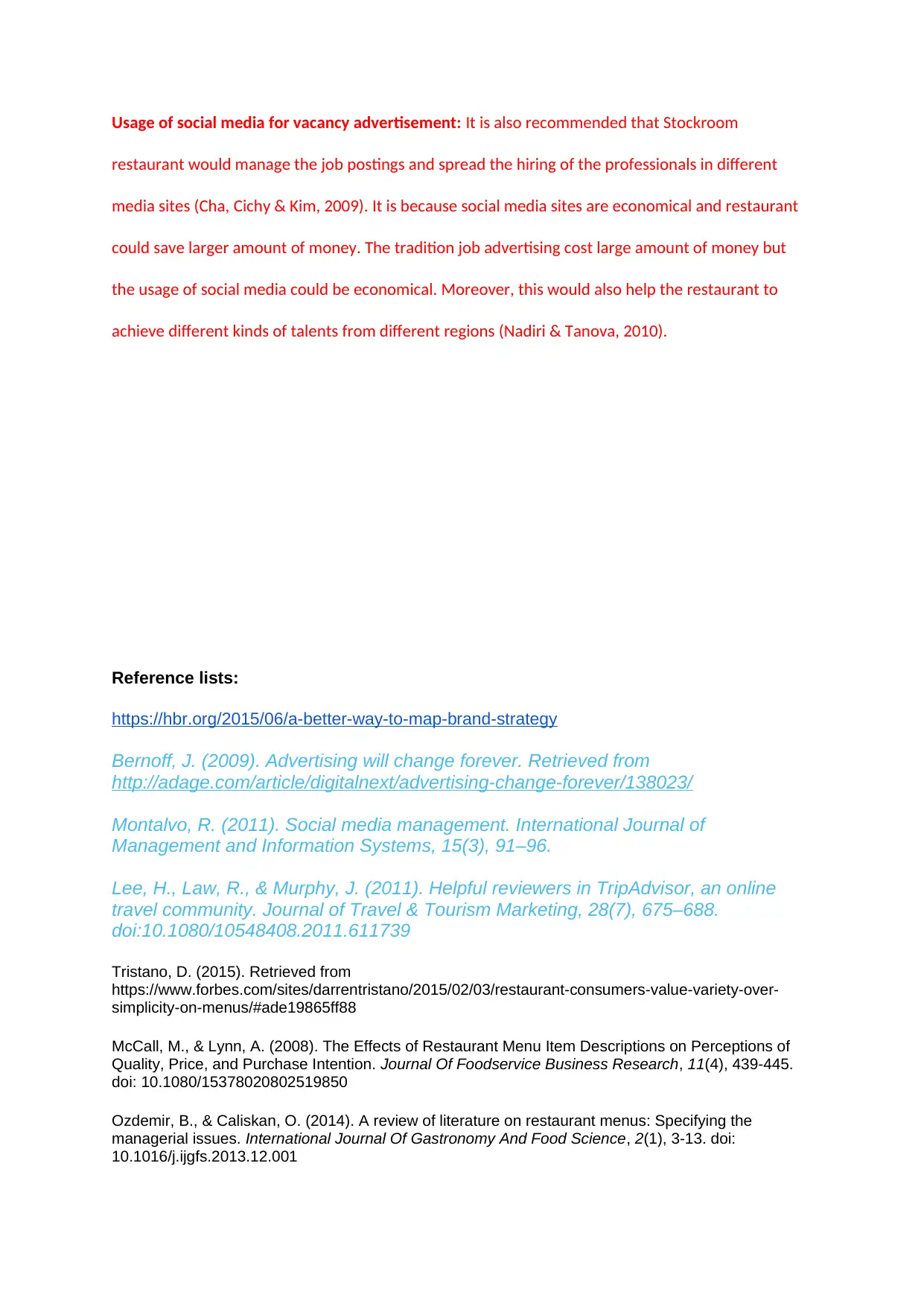
Usage of social media for vacancy advertisement: It is also recommended that Stockroom
restaurant would manage the job postings and spread the hiring of the professionals in different
media sites (Cha, Cichy & Kim, 2009). It is because social media sites are economical and restaurant
could save larger amount of money. The tradition job advertising cost large amount of money but
the usage of social media could be economical. Moreover, this would also help the restaurant to
achieve different kinds of talents from different regions (Nadiri & Tanova, 2010).
Reference lists:
https://hbr.org/2015/06/a-better-way-to-map-brand-strategy
Bernoff, J. (2009). Advertising will change forever. Retrieved from
http://adage.com/article/digitalnext/advertising-change-forever/138023/
Montalvo, R. (2011). Social media management. International Journal of
Management and Information Systems, 15(3), 91–96.
Lee, H., Law, R., & Murphy, J. (2011). Helpful reviewers in TripAdvisor, an online
travel community. Journal of Travel & Tourism Marketing, 28(7), 675–688.
doi:10.1080/10548408.2011.611739
Tristano, D. (2015). Retrieved from
https://www.forbes.com/sites/darrentristano/2015/02/03/restaurant-consumers-value-variety-over-
simplicity-on-menus/#ade19865ff88
McCall, M., & Lynn, A. (2008). The Effects of Restaurant Menu Item Descriptions on Perceptions of
Quality, Price, and Purchase Intention. Journal Of Foodservice Business Research, 11(4), 439-445.
doi: 10.1080/15378020802519850
Ozdemir, B., & Caliskan, O. (2014). A review of literature on restaurant menus: Specifying the
managerial issues. International Journal Of Gastronomy And Food Science, 2(1), 3-13. doi:
10.1016/j.ijgfs.2013.12.001
restaurant would manage the job postings and spread the hiring of the professionals in different
media sites (Cha, Cichy & Kim, 2009). It is because social media sites are economical and restaurant
could save larger amount of money. The tradition job advertising cost large amount of money but
the usage of social media could be economical. Moreover, this would also help the restaurant to
achieve different kinds of talents from different regions (Nadiri & Tanova, 2010).
Reference lists:
https://hbr.org/2015/06/a-better-way-to-map-brand-strategy
Bernoff, J. (2009). Advertising will change forever. Retrieved from
http://adage.com/article/digitalnext/advertising-change-forever/138023/
Montalvo, R. (2011). Social media management. International Journal of
Management and Information Systems, 15(3), 91–96.
Lee, H., Law, R., & Murphy, J. (2011). Helpful reviewers in TripAdvisor, an online
travel community. Journal of Travel & Tourism Marketing, 28(7), 675–688.
doi:10.1080/10548408.2011.611739
Tristano, D. (2015). Retrieved from
https://www.forbes.com/sites/darrentristano/2015/02/03/restaurant-consumers-value-variety-over-
simplicity-on-menus/#ade19865ff88
McCall, M., & Lynn, A. (2008). The Effects of Restaurant Menu Item Descriptions on Perceptions of
Quality, Price, and Purchase Intention. Journal Of Foodservice Business Research, 11(4), 439-445.
doi: 10.1080/15378020802519850
Ozdemir, B., & Caliskan, O. (2014). A review of literature on restaurant menus: Specifying the
managerial issues. International Journal Of Gastronomy And Food Science, 2(1), 3-13. doi:
10.1016/j.ijgfs.2013.12.001
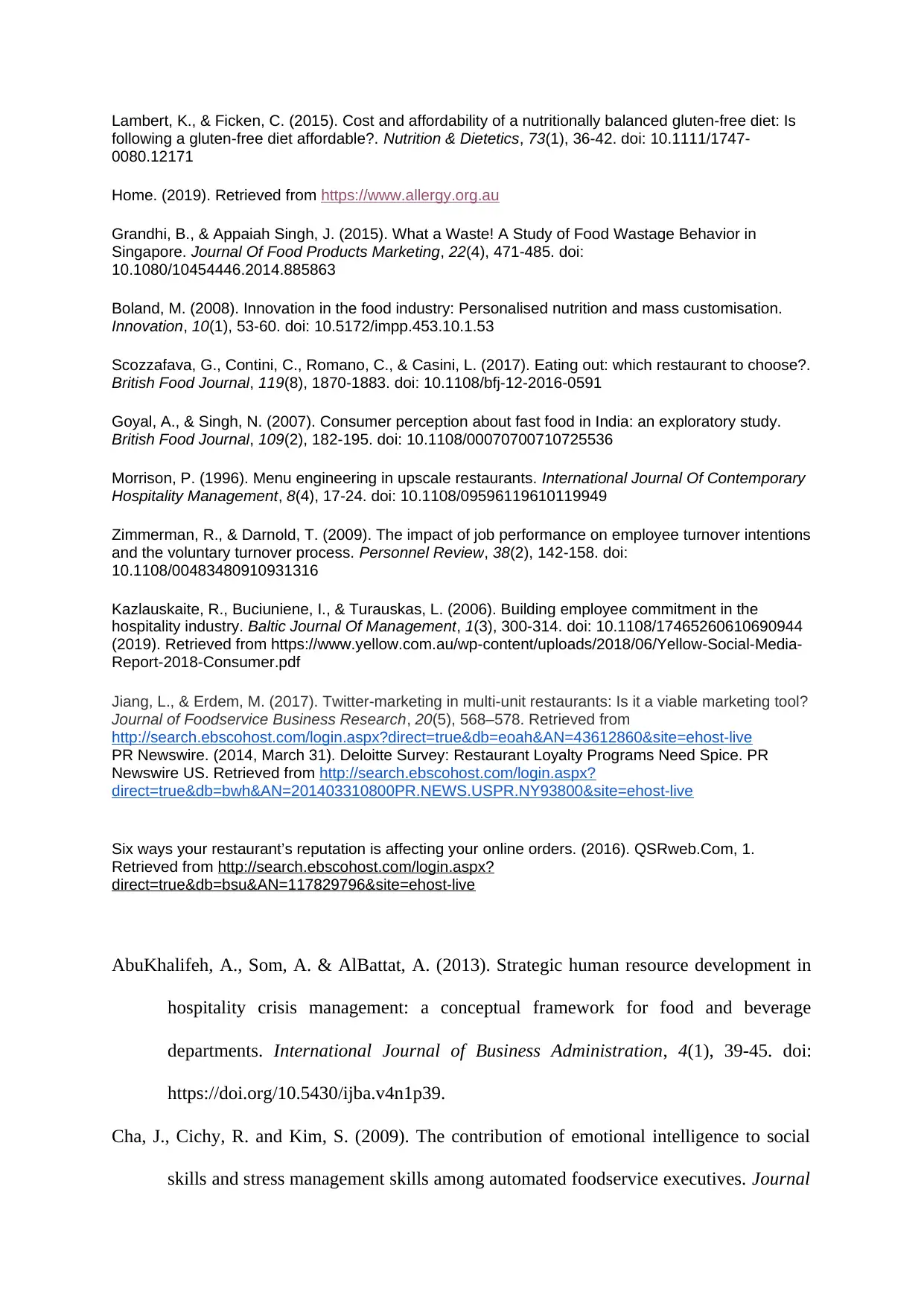
Lambert, K., & Ficken, C. (2015). Cost and affordability of a nutritionally balanced gluten-free diet: Is
following a gluten-free diet affordable?. Nutrition & Dietetics, 73(1), 36-42. doi: 10.1111/1747-
0080.12171
Home. (2019). Retrieved from https://www.allergy.org.au
Grandhi, B., & Appaiah Singh, J. (2015). What a Waste! A Study of Food Wastage Behavior in
Singapore. Journal Of Food Products Marketing, 22(4), 471-485. doi:
10.1080/10454446.2014.885863
Boland, M. (2008). Innovation in the food industry: Personalised nutrition and mass customisation.
Innovation, 10(1), 53-60. doi: 10.5172/impp.453.10.1.53
Scozzafava, G., Contini, C., Romano, C., & Casini, L. (2017). Eating out: which restaurant to choose?.
British Food Journal, 119(8), 1870-1883. doi: 10.1108/bfj-12-2016-0591
Goyal, A., & Singh, N. (2007). Consumer perception about fast food in India: an exploratory study.
British Food Journal, 109(2), 182-195. doi: 10.1108/00070700710725536
Morrison, P. (1996). Menu engineering in upscale restaurants. International Journal Of Contemporary
Hospitality Management, 8(4), 17-24. doi: 10.1108/09596119610119949
Zimmerman, R., & Darnold, T. (2009). The impact of job performance on employee turnover intentions
and the voluntary turnover process. Personnel Review, 38(2), 142-158. doi:
10.1108/00483480910931316
Kazlauskaite, R., Buciuniene, I., & Turauskas, L. (2006). Building employee commitment in the
hospitality industry. Baltic Journal Of Management, 1(3), 300-314. doi: 10.1108/17465260610690944
(2019). Retrieved from https://www.yellow.com.au/wp-content/uploads/2018/06/Yellow-Social-Media-
Report-2018-Consumer.pdf
Jiang, L., & Erdem, M. (2017). Twitter-marketing in multi-unit restaurants: Is it a viable marketing tool?
Journal of Foodservice Business Research, 20(5), 568–578. Retrieved from
http://search.ebscohost.com/login.aspx?direct=true&db=eoah&AN=43612860&site=ehost-live
PR Newswire. (2014, March 31). Deloitte Survey: Restaurant Loyalty Programs Need Spice. PR
Newswire US. Retrieved from http://search.ebscohost.com/login.aspx?
direct=true&db=bwh&AN=201403310800PR.NEWS.USPR.NY93800&site=ehost-live
Six ways your restaurant’s reputation is affecting your online orders. (2016). QSRweb.Com, 1.
Retrieved from http://search.ebscohost.com/login.aspx?
direct=true&db=bsu&AN=117829796&site=ehost-live
AbuKhalifeh, A., Som, A. & AlBattat, A. (2013). Strategic human resource development in
hospitality crisis management: a conceptual framework for food and beverage
departments. International Journal of Business Administration, 4(1), 39-45. doi:
https://doi.org/10.5430/ijba.v4n1p39.
Cha, J., Cichy, R. and Kim, S. (2009). The contribution of emotional intelligence to social
skills and stress management skills among automated foodservice executives. Journal
following a gluten-free diet affordable?. Nutrition & Dietetics, 73(1), 36-42. doi: 10.1111/1747-
0080.12171
Home. (2019). Retrieved from https://www.allergy.org.au
Grandhi, B., & Appaiah Singh, J. (2015). What a Waste! A Study of Food Wastage Behavior in
Singapore. Journal Of Food Products Marketing, 22(4), 471-485. doi:
10.1080/10454446.2014.885863
Boland, M. (2008). Innovation in the food industry: Personalised nutrition and mass customisation.
Innovation, 10(1), 53-60. doi: 10.5172/impp.453.10.1.53
Scozzafava, G., Contini, C., Romano, C., & Casini, L. (2017). Eating out: which restaurant to choose?.
British Food Journal, 119(8), 1870-1883. doi: 10.1108/bfj-12-2016-0591
Goyal, A., & Singh, N. (2007). Consumer perception about fast food in India: an exploratory study.
British Food Journal, 109(2), 182-195. doi: 10.1108/00070700710725536
Morrison, P. (1996). Menu engineering in upscale restaurants. International Journal Of Contemporary
Hospitality Management, 8(4), 17-24. doi: 10.1108/09596119610119949
Zimmerman, R., & Darnold, T. (2009). The impact of job performance on employee turnover intentions
and the voluntary turnover process. Personnel Review, 38(2), 142-158. doi:
10.1108/00483480910931316
Kazlauskaite, R., Buciuniene, I., & Turauskas, L. (2006). Building employee commitment in the
hospitality industry. Baltic Journal Of Management, 1(3), 300-314. doi: 10.1108/17465260610690944
(2019). Retrieved from https://www.yellow.com.au/wp-content/uploads/2018/06/Yellow-Social-Media-
Report-2018-Consumer.pdf
Jiang, L., & Erdem, M. (2017). Twitter-marketing in multi-unit restaurants: Is it a viable marketing tool?
Journal of Foodservice Business Research, 20(5), 568–578. Retrieved from
http://search.ebscohost.com/login.aspx?direct=true&db=eoah&AN=43612860&site=ehost-live
PR Newswire. (2014, March 31). Deloitte Survey: Restaurant Loyalty Programs Need Spice. PR
Newswire US. Retrieved from http://search.ebscohost.com/login.aspx?
direct=true&db=bwh&AN=201403310800PR.NEWS.USPR.NY93800&site=ehost-live
Six ways your restaurant’s reputation is affecting your online orders. (2016). QSRweb.Com, 1.
Retrieved from http://search.ebscohost.com/login.aspx?
direct=true&db=bsu&AN=117829796&site=ehost-live
AbuKhalifeh, A., Som, A. & AlBattat, A. (2013). Strategic human resource development in
hospitality crisis management: a conceptual framework for food and beverage
departments. International Journal of Business Administration, 4(1), 39-45. doi:
https://doi.org/10.5430/ijba.v4n1p39.
Cha, J., Cichy, R. and Kim, S. (2009). The contribution of emotional intelligence to social
skills and stress management skills among automated foodservice executives. Journal
Secure Best Marks with AI Grader
Need help grading? Try our AI Grader for instant feedback on your assignments.
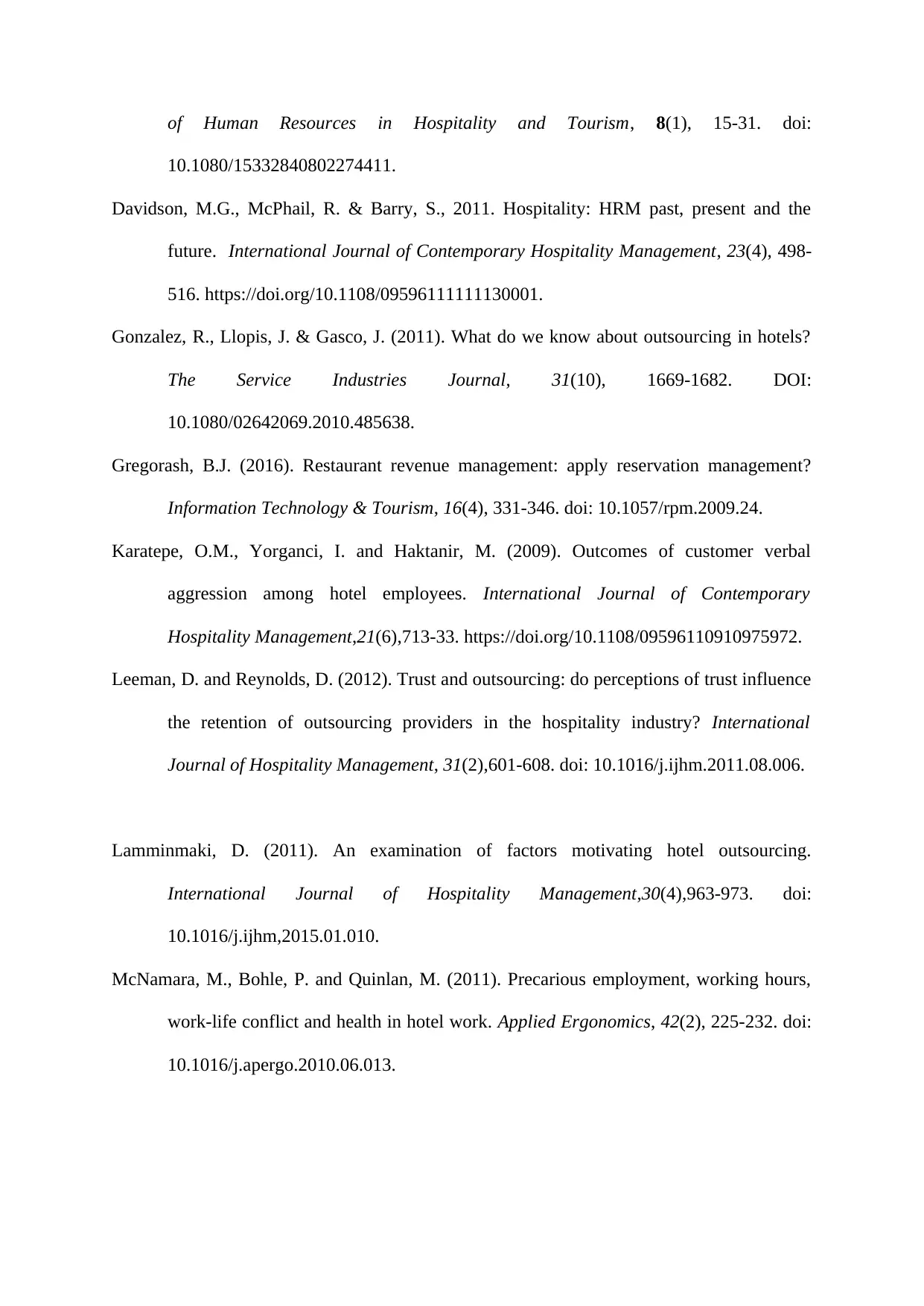
of Human Resources in Hospitality and Tourism, 8(1), 15-31. doi:
10.1080/15332840802274411.
Davidson, M.G., McPhail, R. & Barry, S., 2011. Hospitality: HRM past, present and the
future. International Journal of Contemporary Hospitality Management, 23(4), 498-
516. https://doi.org/10.1108/09596111111130001.
Gonzalez, R., Llopis, J. & Gasco, J. (2011). What do we know about outsourcing in hotels?
The Service Industries Journal, 31(10), 1669-1682. DOI:
10.1080/02642069.2010.485638.
Gregorash, B.J. (2016). Restaurant revenue management: apply reservation management?
Information Technology & Tourism, 16(4), 331-346. doi: 10.1057/rpm.2009.24.
Karatepe, O.M., Yorganci, I. and Haktanir, M. (2009). Outcomes of customer verbal
aggression among hotel employees. International Journal of Contemporary
Hospitality Management,21(6),713-33. https://doi.org/10.1108/09596110910975972.
Leeman, D. and Reynolds, D. (2012). Trust and outsourcing: do perceptions of trust influence
the retention of outsourcing providers in the hospitality industry? International
Journal of Hospitality Management, 31(2),601-608. doi: 10.1016/j.ijhm.2011.08.006.
Lamminmaki, D. (2011). An examination of factors motivating hotel outsourcing.
International Journal of Hospitality Management,30(4),963-973. doi:
10.1016/j.ijhm,2015.01.010.
McNamara, M., Bohle, P. and Quinlan, M. (2011). Precarious employment, working hours,
work-life conflict and health in hotel work. Applied Ergonomics, 42(2), 225-232. doi:
10.1016/j.apergo.2010.06.013.
10.1080/15332840802274411.
Davidson, M.G., McPhail, R. & Barry, S., 2011. Hospitality: HRM past, present and the
future. International Journal of Contemporary Hospitality Management, 23(4), 498-
516. https://doi.org/10.1108/09596111111130001.
Gonzalez, R., Llopis, J. & Gasco, J. (2011). What do we know about outsourcing in hotels?
The Service Industries Journal, 31(10), 1669-1682. DOI:
10.1080/02642069.2010.485638.
Gregorash, B.J. (2016). Restaurant revenue management: apply reservation management?
Information Technology & Tourism, 16(4), 331-346. doi: 10.1057/rpm.2009.24.
Karatepe, O.M., Yorganci, I. and Haktanir, M. (2009). Outcomes of customer verbal
aggression among hotel employees. International Journal of Contemporary
Hospitality Management,21(6),713-33. https://doi.org/10.1108/09596110910975972.
Leeman, D. and Reynolds, D. (2012). Trust and outsourcing: do perceptions of trust influence
the retention of outsourcing providers in the hospitality industry? International
Journal of Hospitality Management, 31(2),601-608. doi: 10.1016/j.ijhm.2011.08.006.
Lamminmaki, D. (2011). An examination of factors motivating hotel outsourcing.
International Journal of Hospitality Management,30(4),963-973. doi:
10.1016/j.ijhm,2015.01.010.
McNamara, M., Bohle, P. and Quinlan, M. (2011). Precarious employment, working hours,
work-life conflict and health in hotel work. Applied Ergonomics, 42(2), 225-232. doi:
10.1016/j.apergo.2010.06.013.

Mun, S.G. and Jang, S. (2018). Restaurant operating expenses and their effects on
profitability enhancement. International Journal of Hospitality Management, 71, 68-
76. https://doi.org/10.1108/09596111111167560.
Nadiri, H. and Tanova, C. (2010). An investigation of the role of justice in turnover
intentions, job satisfaction and organizational citizenship behaviour in hospitality
industry. International Journal of Hospitality Management,29(1), 33-41.
doi:10.1016/j.na.2008.10.003.
Noone, B.M. and Maier, T.A. (2015). A decision framework for restaurant revenue
management. Journal of Revenue and Pricing Management, 14(4), 231-244.
https://doi.org/10.1057/rpm.2015.15.
Solnet, D., Kralj, A. and Baum, T. (2013). 360 Degrees of Pressure: The Changing Role of
the HR Professional in the hospitality industry. Journal of Hospitality and Tourism
Research, 22(6), 1-22. doi:10.3390/su8080809.
Wang, Y.F., Horng, J.S., Cheng, S.Y. and Killman, L. (2011). Factors influencing food and
beverage employees’ career success: a contextual perspective. International Journal
of Hospitality Management, 30(4), 97-1007. doi:10.3390/su8080809.
Yap, Q.S. and Webber, J.K. (2015). Developing corporate culture in a training department: a
qualitative case study of internal and outsourced staff. Review of Business & Finance
Studies, 6(1), 43-56. doi:10.1002/hrdq.21180.
profitability enhancement. International Journal of Hospitality Management, 71, 68-
76. https://doi.org/10.1108/09596111111167560.
Nadiri, H. and Tanova, C. (2010). An investigation of the role of justice in turnover
intentions, job satisfaction and organizational citizenship behaviour in hospitality
industry. International Journal of Hospitality Management,29(1), 33-41.
doi:10.1016/j.na.2008.10.003.
Noone, B.M. and Maier, T.A. (2015). A decision framework for restaurant revenue
management. Journal of Revenue and Pricing Management, 14(4), 231-244.
https://doi.org/10.1057/rpm.2015.15.
Solnet, D., Kralj, A. and Baum, T. (2013). 360 Degrees of Pressure: The Changing Role of
the HR Professional in the hospitality industry. Journal of Hospitality and Tourism
Research, 22(6), 1-22. doi:10.3390/su8080809.
Wang, Y.F., Horng, J.S., Cheng, S.Y. and Killman, L. (2011). Factors influencing food and
beverage employees’ career success: a contextual perspective. International Journal
of Hospitality Management, 30(4), 97-1007. doi:10.3390/su8080809.
Yap, Q.S. and Webber, J.K. (2015). Developing corporate culture in a training department: a
qualitative case study of internal and outsourced staff. Review of Business & Finance
Studies, 6(1), 43-56. doi:10.1002/hrdq.21180.
1 out of 15
![[object Object]](/_next/static/media/star-bottom.7253800d.svg)

